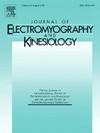膝关节位置感评估中的肌肉协同激活:肌肉疲劳的影响和误差和方向偏差的大小的含义
IF 2.3
4区 医学
Q3 NEUROSCIENCES
引用次数: 0
摘要
目的本研究旨在描述健康个体在肌肉疲劳前后膝关节位置感(KJPS)评估过程中的肌肉协同激活,并分析误差大小和方向偏差的影响。方法21例健康男性,采用同心式(SIT_CC)和偏心式(SIT_ECC)膝关节屈曲45°的坐姿,评估KJPS。测试了两种疲劳方案,包括膝关节伸肌或屈肌的同心收缩。根据股外侧肌和股二头肌的归一化平均激活值计算肌肉共激活指数。计算绝对误差和相对误差,根据误差的大小(低误差vs高误差)和方向偏差(伸展vs屈曲)对参与者进行分组。结果活化指数在74.92% ~ 98.43%之间。两种疲劳方案后共活化指数总体显著下降(p < 0.05)。误差大小组之间的共激活没有显著差异(p > 0.05),但在未能完成目标体位屈曲的参与者中观察到显著更高的共激活,只有在SIT_CC测试中(0.001 < p < 0.042)。结论在JPS试验中,膝关节伸屈肌之间的肌肉协同激活程度较高,疲劳后肌肉协同激活程度降低。肌肉共激活似乎不能解释误差的大小,但它似乎影响方向偏差。本文章由计算机程序翻译,如有差异,请以英文原文为准。
Muscle coactivation during knee joint-position sense assessments: the effect of muscle fatigue and implications for the magnitude of errors and directional bias
Purpose
This study aimed to describe muscle coactivation during knee joint-position sense (KJPS) assessments in healthy individuals, before and after muscle fatigue, and to analyse the implications for the magnitude of errors and directional bias.
Methods
The KJPS of 21 healthy males was assessed in the sitting position through concentric (SIT_CC) and eccentric repositionings (SIT_ECC) to 45° of knee flexion. Two fatigue protocols were tested, consisting of concentric contractions of the knee extensors or flexors. Muscle coactivation indices were calculated based on the normalized mean activation of the vastus lateralis and biceps femoris muscles. Absolute and relative errors were calculated to group participants by magnitude of errors (lower vs. higher errors) and directional bias (extension vs. flexion).
Results
Coactivation indices ranged between 74.92 % - 98.43 %. Significant overall decrease in coactivation indices after both fatigue protocols (p < 0.05). No significant differences in coactivation were found between magnitude of errors groups (p > 0.05), but significant higher coactivation were observed in participants failing the target position into flexion, only in the SIT_CC test (0.001 < p < 0.042).
Conclusion
Muscle coactivation between knee extensors and flexors was high in the assessed JPS tests, and decreased after fatigue. Muscle coactivation does not appear to explain the magnitude of errors, while it seems to influence directional bias.
求助全文
通过发布文献求助,成功后即可免费获取论文全文。
去求助
来源期刊
CiteScore
4.70
自引率
8.00%
发文量
70
审稿时长
74 days
期刊介绍:
Journal of Electromyography & Kinesiology is the primary source for outstanding original articles on the study of human movement from muscle contraction via its motor units and sensory system to integrated motion through mechanical and electrical detection techniques.
As the official publication of the International Society of Electrophysiology and Kinesiology, the journal is dedicated to publishing the best work in all areas of electromyography and kinesiology, including: control of movement, muscle fatigue, muscle and nerve properties, joint biomechanics and electrical stimulation. Applications in rehabilitation, sports & exercise, motion analysis, ergonomics, alternative & complimentary medicine, measures of human performance and technical articles on electromyographic signal processing are welcome.

 求助内容:
求助内容: 应助结果提醒方式:
应助结果提醒方式:


